Biographical Essay
Gael Newton, March 1980, Sydney
In 1928, whilst at Sydney Grammar School, Max Dupain won the Carter Memorial Prize for Productive Use of Spare Time with an exhibition of his landcape photographs. The images were gently romantic and modelled on the Pictorial style of art photography (pl 2).
Pictorialism had prevailed in Australia since the turn of the century, when it emerged as part of a vogue for Impressionist effects. Theoretically the movement was an extension of the eighteenth century notions of the Picturesque and nineteenth century Romantic ideas.
During the twenties there was a reaction to the soft focus and low tone of early Pictorial images and attempts were made to establish a national school based on Australian sunlight patterns. By 1928 the influence of Art Deco was seen in the shift to clearer outlines, geometric forms and patterns, dramatic angles and contrasts in lighting. This phase is visible in the work of progressive Pictorialists, such as Harold Cazneaux (1878-1953) whose images Martin Place and Sydney Surfing represent a response to the increased pace of contemporary urban life and the vogue for modernity in design (figs 1 & 2). |
|
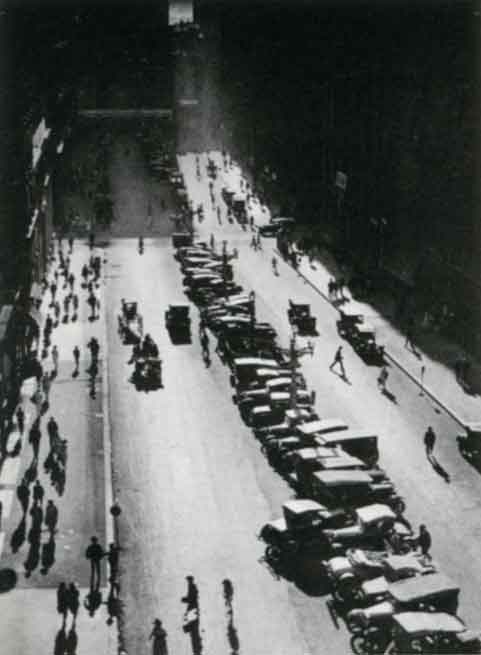 |
| |
Fig. 1 Martin Place - Harold Cazneaux 1928 |
As a student in 1928, Dupain was attracted by the nostalgia in the poetry of Alfred Noyes and John Masefield whose works he occasionally illustrated in sketches or photographs. If Dupain had read an article in The Home magazine 1928, which speculated on the future development of Sydney, he would probably have been bewildered by the ecstatic embrace of modern technology advocated by its writer, Jean Curlewis:
It is possible that a year or two hence we shall lead our visitors to Walsh Bay or Darling Island and bid them mark the pattern of bold masses and intricate detail made against the sky by wheat silos, oil tanks, cranes, girders, cables, cylinders, cones, spirals? Shall we bid them wait until the fly wheels revolve, the driving belts run, the dynamos purr, till the air is full of the rhythm and sheen of whirring wheels?
And then pointing to
. . .' the keen
Passionless beauty of a great machine'
shall we say,
There static no longer, but dynamic—is the architecture of Sydney To-morrow?1
Harold Cazneaux would have probably read the article, as his own pictures were a regular feature of The Home, including the 'Special Sydney Number' in which the article appeared. Yet it was Dupain whose future work would express the vision of 'The Sydney of To-morrow', despite the modernity of Cazneaux's work at the time.
Throughout the thirties Pictorialists found it harder and harder to share Curlewis' enthusiasm for the character of twentieth century society. On a deeper level such intense emotionalism was alien to the harmonious and graceful beauty the Pictorialists sought in their images.
In 1928 neither Cazneaux nor Dupain knew of the development of a new photographic aesthetic which consciously sought to confront, integrate and express the industrialised societies which had developed so rapidly in the 1920s.
Such an aesthetic, termed the 'New Photography' or sometimes the 'New Objectivity', was articulated and demonstrated chiefly in Germany in the late twenties with the publication in 1928 of Albert Renger-Patzsch's book Die Welt 1st Schon (The World is Beautiful), and the highly successful 'Film und Foto' (Film and Photo) exhibition in Stuttgart in 1929. |
|
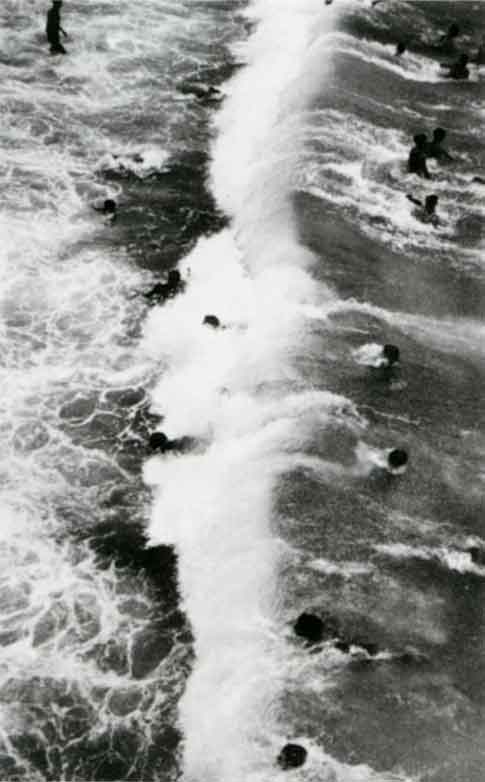 |
| |
Fig. 2 Sydney Surfing –- Harold Cazneaux c1928 |
Laszlo Moholy-Nagy's pioneering book Malerei, Photographie, Film (Painting, Photography, Film) of 1925 might have been known in Australian avant-garde art circles but not in the photographic world until 1930 when it was advertised in the Australasian Photo-Review. Events and publications such as these endeavoured to collate and express the technological advances in all aspects of photography — film, scientific recording, press illustration and advertising —as well as the impact they had on visual awareness.
An announcement in 1928 for the forthcoming 'Film und Foto' exhibition stressed the variety and visual potential of the new photography over the limited range of subject and treatment of the Pictorialists:
A new optic has developed. We see things differently now, without painterly intent in the impressionistic sense. Today things are important that earlier were hardly noticed: for example shoe lasts, gutters, spools of thread, fabrics, machines, etc. They interest us for their material substance, for the simple quality of the thing-in-itself; they interest us as the means of creating space-form on surfaces, as the bearers of the darkness and the light—( The darkness and the light—basic form-creation of photography!)2
The New Photography was characterised by exploration of the close-up, bird's-eye, asymmetrical and unnaturalistic perspectives of the camera. The development of smaller, more flexible, cameras seemed to have liberated vision itself. Earlier photographs had a static feeling of the linear perspective of the traditional artist seated squarely on his stool sketching a subject neatly framed as if through a window.
This one-point perspective was replaced by images seemingly made by a gyroscope systematically recording all visual angles through a 360 degree turn. The new images were fragments, like stills from a film, which if reconstituted might have made up a traditional 'scene' or story. They were unsentimental and impersonal, and concerned with preexisting formal relationships or those created by the particular perspective chosen in the viewfinder. Just as modern painting had rejected representation and naturalism for abstract formal relations, so did photography.
This New Photography, as such, was largely unknown in Sydney in 1928, but its visual characteristics had already been disseminated through advertising techniques.3 The novelty and success of the style in depicting objects—products—had proved ideally suited to the needs of consumer promotion.
In the late twenties the local photographic magazines regularly reported on the dazzling achievements of commercial photography shows overseas. By 1930 the editors of the Australasian Photo-Review enthusiastically recommended Das Deutsche Tichtbild and Modern Photography annuals which provided Australian photographers with their first significant contact with the ideas and images of modern photography.4
An acute awareness of the challenge presented by modern city life is also evident in a review of the Kodak Salon by Cazneaux in the Australasian Photo-Review issue for February 1930. In the last paragraph, after a copious review of the exhibition, Cazneaux abruptly changes his writing into a stream of consciousness style to express the contrast between the gentle world of the Pictorial exhibition and his:
'drop' . . . in the modern lift. . . to the modern bustle of our modern city streets, where electric trams, motor cars, concrete and steel colour and human beings seem all messed up and doing jazz! . . . Here are subjects waiting to be treated . . . the jazz of moving shapes makes patterns on the steel whilst up above against the sunset sky is the jazz-like serrated edge of the up and down masses of concrete and steel. 5
It was this climate of ideas and experiment that Dupain entered after leaving school in 1930 to seek a career in photography. Society had already been physically transformed by new technology. It was, therefore, predisposed to and conscious of the need for a contemporary expression through an aesthetic totally different from Pictorialism.
Maxwell Spencer Dupain was born in Sydney in 1911, the only child of George (of French descent) and Ena (of Irish descent) Dupain. George Dupain was a notable pioneer in the fields of physical education, biochemistry and nutrition. In the twenties he built up a gymnasium in Sydney run on the most advanced scientific lines.
Dupain senior had aspired to a career in medicine but came to channel his scientific abilities into extensive writings on the subject of physical education. Apart from a commitment to physical discipline Max Dupain did not follow his father's scientific bent. He showed little aptitude for scholarship despite the high academic standards of Sydney Grammar School. Stimulated by his parents' library, he did, however, develop a love of English literature. But his main interests were sport and photography, probably in that order.
In 1924 Dupain received his first camera, a 'Box Brownie', as a gift from an uncle. This was followed in 1926 by a 'vest pocket' camera from his grandmother. Dupain felt a strong affinity for the physical manipulation and movement required in photography as well as for the direct nature of its expression. He had done some sketching but showed greater talent at photography. By 1928 he had determined on a career in that held. Dupain stayed on at school until after the rowing season in 1930 when an introduction from Albert Collins, Art Director of the leading advertising hrm of Smith and Julius, led to his beginning work in the studio of Cecil Bostock.
Cecil Bostock (1884 1939) was a prominent Pictorialist and one of the new breed of commercial photographers created by the demand for up-to-date images in the rapidly expanding held of magazine illustration. He was active in all the Pictorial societies including the elite Sydney Camera Circle (modelled on the pioneer British Pictorialist group, The Linked Ring) which he helped to found in 1916.
Bostock was a gifted graphic designer, having hrst worked as a commercial artist before setting up as a photographer in 1917. His graphic work was decorative and delicate in contrast to his photographs which were more reserved and direct than the soft atmospheric style of his Pictorial colleagues. He was, however, a difficult and erratic character who retained few close friends or working assistants. |
|
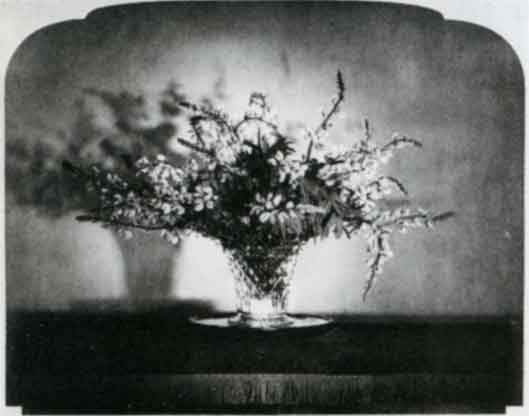 |
| |
Fig. 3 Lupins- Cecil Bostock 1927 |
Dupain found Bostock a distant personality whose only doctrine seemed to be one of technique, despite his advocacy of photography as an art form. Dupain found it was something of a 'moral and physical struggle' to reconcile his personality with that of his teacher. I spent', he later wrote, 'three years with this very thorough craftsman and the study of his exacting and original methods formed a solid background for my future work and development. It was a tortuous experience for such a sensitive fresher . . .'6
Dupain joined the New South Wales Photographic Society in 1929, whilst still at school, and by 1930 was exhibiting landscapes and still life studies in the Society's competitions and salons. The works of these early years (pls 1 and 3) were assured but conventional Pictorial studies.
The Bostock studio was known for still life product advertisements (fig 3) and the discipline of this work, for which Dupain also had an affinity, may have encouraged a greater feeling for design.
This was seen in the bold division, by dramatic contrast of light and dark, of a gentle scene of quarry works (pl 5). The more intense character of Newport Quarry is emphasised in the wild forces shown in Flight of the Spectres of 1932 (pl 4).
Such strong treatment and dramatic lighting were to become characteristic of much of Dupain's work throughout the thirties and forties. However, the poignancy shown in Palm Beach Fandscape of 1930 (pl 1) appears from time to time in later works (pl 51) as a contrast to this dramatic mode.
Two images of 1933—35, Silos—Morning (fig 4) and Industrial Fandscape (pl 10), mark an abrupt end to Dupain's use of Pictorialist modes. Industrial subject matter was adopted by Pictorialists in the 1930s, but their images followed the Impressionist tradition of dazzling atmospheric effects. For example, John Kauffmann (1864—1942), who had introduced Pictorialism to Australia in 1897, used industrial and urban objects as did Cazneaux and Henri Mallard (1888—1967), but their subjects were given a picturesque atmosphere (figs 5 and 6).
Dupain's Silos—Morning was a radical departure from the naturalism and atmospheric effects of the Pictorialists. His decision to use a low viewpoint emphasised the semi-abstract treatment of the subject.
Whilst not depicting as dynamic and mechanistic a world as that predicted by Jean Curlewis in The Home magazine, Dupain's image would have satisfied her hypothetical admirers of 'bold masses . . . against the sky'. |
|
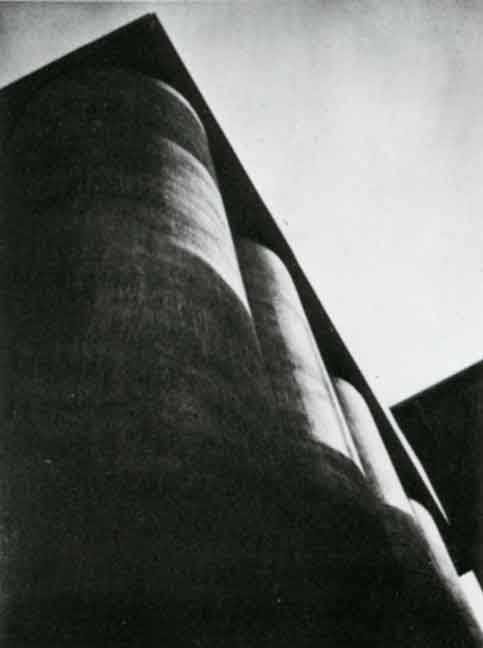 |
| |
Fig. 4 Silos-Morning - Max Dupain 1933 |
The image caused a stir at the New South Wales Photographic Society but was defended by Bostock whose concept of art photography was not so rooted in old formulas. The Bostock studio did industrial assignments for a local engineering firm and this may have increased his sympathies to new approaches.
However, Silos—Morning was one of a series Dupain made in his spare time and was not commissioned. The catalyst for Dupain's shift to clear geometric, or 'modernist', forms appears to have been his contact with Das Deutsche Fichtbild, Photographie and Modern Photography.7
As well, the Australasian Photo-Review had been regularly reporting on new developments in London including the 1932 'Modern Spirit' exhibition at the Royal Photographic Society. Illustrations were scanty and readers had to rely on the verbal descriptions of their conservative correspondent—Pictorialist,
Reverend H. O. Fenton—for an account of 'The Modern Spirit':
Nothing is depicted in the ordinary conventional way . . . the subject can be viewed from a distorting angle, . . . the part is greater than the whole . . . two entirely different objects are superimposed on one plate . . . these things are magnificently portrayed in faultless technique.8
An essay by G. H. Saxon Mills in Modern Photography for 1931 which Dupain read in 1933 was to be influential in the development of his ideas. In this essay Saxon Mills described photography as a relatively new medium with
no past to obscure its future . . . It belongs to the new age. Its forms are mechanistic rather than naturalistic. It is part and parcel of the terrific and thrilling panorama opening out before us to-day—of clean concrete buildings, steel radio masts, and the wings of the air liner. But its beauty is only for those who themselves are aware of the fieitgest' —who belong consciously and proudly to this age, and have not their eyes forever wistfully fixed on the past.9
|
|
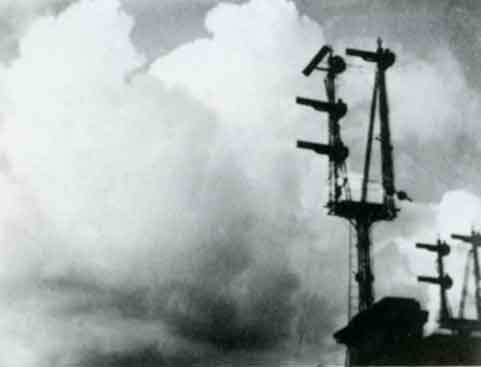 |
| |
Fig. 5 The Cloud - John Kauffman c 1910 |
Saxon Mills carefully distinguished the New Photography from simple naturalism or documentation. Surface detail and excessive naturalism were meaningless unless the beauty of the underlying forms was apparent. The role of modern photography, he said, was to expose to those who valued only the past models of beauty, 'the vivid and exciting reality behind the common places which alone we see'. The subjective vision of the photographer was the medium through which the qualities of the objective world were revealed. Because this 'abstract aesthetic charm' was the primary aim of the photographer, it was important to control experiments with photomontage and similar manipulations in order not to lose contact with objective reality. Ideally, Saxon Mills saw the photograph
as an expressionist work of art . . . [a] half way house between the purely mental creation of the abstract design and the Academician's adumbration of the obvious.10
In pointing out that the camera registers form, not sentiments, Saxon Mills asserted the formal priorities of modern photography. He argued, for example, that a scene of tenements might bring to mind the social problems of unequal wealth and unemployment. However, he asserted that knowledge of these aspects was not properly the concern of photographers but of sociologists. The camera's value lay in revealing the essential beauty of the world regardless of changing personal or social problems.
Chiefly, it was its characterisation of the role of the photographer as a revealer of 'intrinsic form' that separated the New Photography from the Pictorialists, for the latter believed in creating an ideal beauty out of an imperfect natural world. However, both schools were committed to notions of 'Beauty' as apprehended by the lens and the theoretical differences between old and new aesthetics did not at first necessarily imply an antithesis.
Therefore it was possible for Pictorialists like Cazneaux to introduce more modern styling into their images. Light patterns were a popular means of introducing clearer outlines and geometric shapes but these were presented decoratively in a naturalistic context. |
|
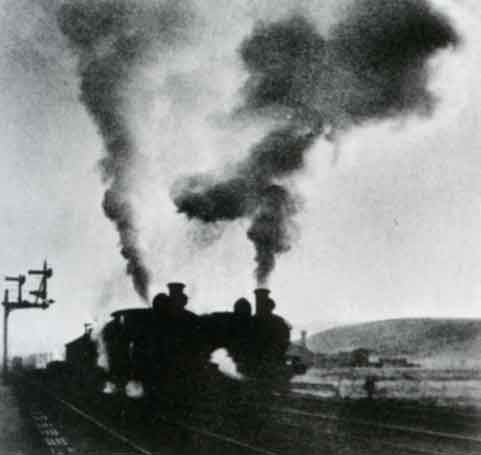 |
| |
Fig. 6 Break-A-Day Railway Siding - Henri Mallard 1939 |
The Pictorialists, however, did not really warm to modern life as a subject and by the late thirties they represented a reactionary movement, clinging to traditional social values as much as to traditional formal techniques. It is not surprising that the members of the Photographic Society found Silos—Morning disturbing for it was not a Pictorialist image.
The use of an unusual camera perspective drew attention to the medium and stressed the abstract formal qualities of the subject. Rather than idealising the subject or accenting the picturesque, Dupain's image suggested the autonomy of the picture. Pictorialists may have been keen to update their images, but the ideological lines were drawn when it came to abstraction or distortion.
During 1933, in his last year at Bostock's studio, Dupain experimented with design and the modulation of form by both natural and artificial light. He had been attending painting and drawing classes at night at Julian Ashton's Art School (under Henry Gibbons) and later East Sydney Technical College (under Douglas Dundas).
Neither school was particularly progressive but a group of Ashton's students—Peter Dodd, Chris Van Dyke and Rosette and Helen Edmonds—used to meet, after class, at Dupain's studio to discuss new ideas in all fields. The music of avant-garde composers such as Ravel, Stravinsky, Debussy and Schoenberg was played at these meetings and the colour-music theories of Alec Hector, in particular, were discussed.
A small legacy from his grandmother encouraged Dupain to set up independently in 1934. He acquired a Thornton Pickard camera and began work in his own studio darkroom in Bond Street, Sydney. The worst of the Depression was over and photo-illustration was again an expanding field. The challenge of the variety of commercial assignments necessary for a studio to survive and his new independence and responsibility seem to have assisted Dupain to develop greater sophistication and maturity in his work.
Professionally he gained a reputation for fine still life, figure and portrait work. The Home magazine began to include examples of his personal as well as commercial work. Dupain's personal work demonstrated the expressive potential of the New Photography which to date had been associated only with the slick advertisements and fashion illustrations from Russell Roberts' studio which filled most issues of The Home in the early thirties.
From 1934 Dupain ceased working in the Pictorial style and began a series of nude studies—a subject rarely attempted by his former associates. He continued exploring still life and industrial subjects as well as landscapes. In their preference for solid clear forms dramatised by light, the new works established Dupain's photographic signature.
The unruly emotionalism of such earlier works as Flight of the Spectres was disciplined by reducing forms to essentials, located in tightly defined spaces. Where Silos—Morning (fig 4) has been softened down by overall diffusion, a new image, Wheat Silos Pjrmont of1935 (pl 11), was uncompromising and totally assured. It is surely one of Dupain's earliest major works. Other recently unearthed still life studies which appear to belong to this period, Kerosene Tamp (pi 6) and Eggs (pl 7), show how firmly Dupain's visual vocabulary was established. A figure study of 1935, Spontaneous Composition (pl 25), renders the anatomical elements in the manner of a still life.
With the exception perhaps of the Silos Through Windscreen (pi 9), Dupain was not emotionally involved with machinery as such. His work is more aligned with the functionalist, aesthetic exhibited in modern architecture than with any of the frenetic dynamism associated with machine age aesthetics.
There exists instead an emotional and sensual quality in his images which became more accentuated in the following years. Works such as these form the first body of images in Australian photography to express seriously a modern aesthetic. In 1935 Dupain became acquainted with the more experimental side of the new photography through J. T. Scoby's book, Man Ray.11 Dupain enthusiastically reviewed the book in The Home in October 1935.12 He defended any suggestion that Man Ray's work was simply 'experimental novelty' by pointing to the success with which technique and aesthetics were united with Man Ray's 'lust for simplicity'. No subject seemed to be beyond Ray's ability to represent his observation by selecting the most essential lines and masses.
Dupain was inspired to experiment with new techniques, producing his own 'Rayographs', solarisations, bas reliefs, negative prints and photomontage. The impact of Man Ray and associated figures can be seen in a portfolio of Dupain's work in the November 1935 edition of prestigious art journal, Art in Australia. In addition to realistic still lifes, there were studies of nudes posed with disparate objects and a montage of hands. The light quality is sensuous and dramatic throughout. The Art in Australia selection did not include any of the industrial images and indeed their more austere, radical vision would have jarred in comparison.
The commentary accompanying Dupain's portfolio carried a quote from Saxon Mills' essay of 1931 and was followed on the same page by a review of Modern Photography, 1935—6, which proclaimed that photography had come of age as an art form in 'new work in which design, pattern and composition were the chief elements'. The purpose and function of such designs and the more profound concept of form central to the New Photography were bypassed.
The recognition in Art in Australia was followed by a period of prolific and varied output in Dupain's professional and personal work. Experiments with the language of manipulation continued and included the elaborate montages and assemblages with literary titles such as Apotheosis of Man and Birth of Venus (fig 7) which seem more indebted to developments in film from Eisenstein to Charlie Chaplin than to the surrealism they were associated with.
The best formally and emotionally resolved image in this vein was Impassioned Clay (pl 21) of 1936 named from the title of a Llewellyn Powys book of 1931. Around this time portraiture became an important area, particularly studies of creative artists such as the sensitive image of a visiting string quartet (pl 38). The nudes took on a monumental and yet sensual quality which was absent in the more distant glamour of the early studies. Similarly, still life and figure studies escalated in scope and drama, for example Sunhaker (pl 28) of 1937 and Two Forms (pl 18) of 1939. Urban subject matter as in Finer by Night 1940 (pl 13) was subjected to formal analysis in terms of gigantic still life.
Dupain's work in the late thirties was diverse in subject matter but united in the degree to which, whether still life or scenes, most images were not simply representational in intention but were studies in formal relationships. However, it is important to examine Dupain's first mature body of work not only in terms of a theory of pure 'Form' but in terms of a theory of that form as an expression of the artist's emotional response to the object and his perception of relations between aspects of physical and emotional entities.
Impassioned Clay suggests the correspondence of formal structure between the twist of the female torso and the exposed spiral structure of a broken shell. Two Forms contrasts machine and natural forms of a shell and the head of a hammer. Two torsos of 1938 and 1939 (pls 36 and 32) deliberately emphasise the skeletal structure beneath soft flesh, yet affirm the contact of that flesh with the warmth of the sun, the texture of a blanket or a sand dune. Sunbaker and Form at Bondi (pl 27) are more involved, as the latter title conveys, with the discovery of large forms in figures frozen in movement. |
|
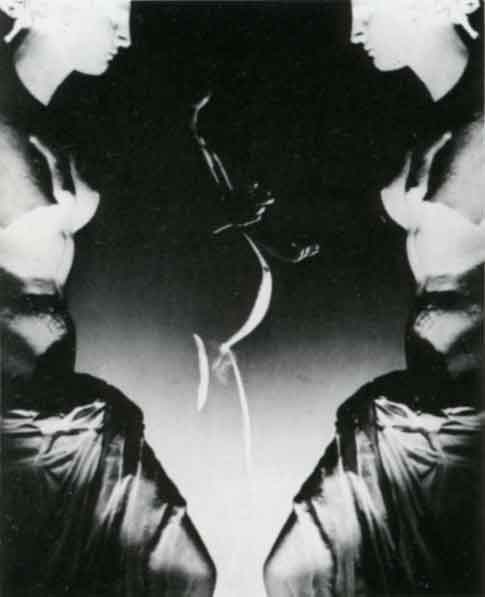 |
| |
Fig. 7 Birth of Venus - Max Dupain 1936 |
The strength of these images arises less from a sense of design than from a concern with the record of an intense 'decisive moment' of contact and response by the photographer to the subject.
From the late thirties Dupain's work shows increasing skill in reconciling the naturalistic and spontaneous image with a formal structure. Later images such as Backyard—Forster of 1940 (pl 46), The Floater 1939 (pl 29), Tathra 1950 (pl 47) and finally At Newport 1952 (pl 48) are more complex in design and depth of field yet less obviously constructed than the large clear forms and shallow space of earlier images. In particular, At Newport resolves the difficult challenge of fitting a network of moving figures into a seemingly effortlessly captured momentary formal relationship.
The direction towards greater naturalism in Dupain's images of the prewar years reflected the general growth of interest in what became known as the Documentary film movement. One of the earliest Australian exponents of this approach was Damien Parer (1912–1944) who worked in Dupain's Bond Street studio in 1938 whilst awaiting an opportunity to work in film.13
Parer later became famous for his documentary films on World War II battles. He introduced Dupain to the films of Robert Flaherty, Pare Lorentz, Joris Ivens and John Grierson. However it was not until Dupain worked for a Royal Australian Air Force camouflage unit during his war service that he became really involved with the Documentary approach.
The prewar years had seen an exciting and varied commercial and personal development for Dupain and during that period he enjoyed the rather glamorous image bestowed on professional photographers, especially those who created portraits of stage and society figures. |
|
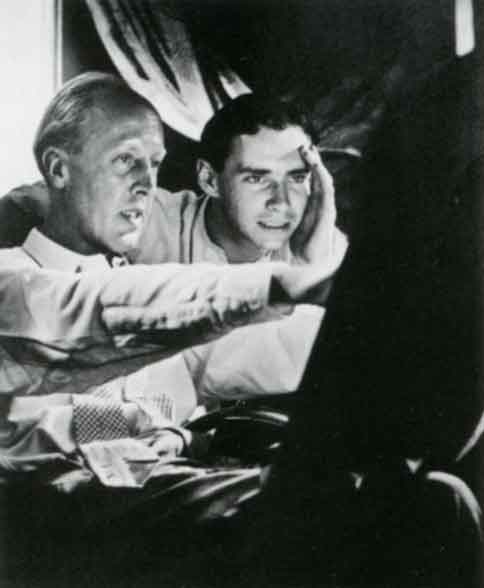 |
| |
Fig. 8 Max Dupain with George Hoyningen-Huene, Sydney 1937 - Geoffrey Powell |
His first major publication came in 1937 with the publication of Soul of a City which Dupain illustrated.14
Fashion illustrations, too, provided a never-ending flow of assignments but they never appealed to Dupain as creative ends in themselves as they did to overseas photographers such as Cecil Beaton. He was impressed with George Hoyningen-Huene's work in Harper's Bazaar and was thrilled to meet him when the German photographer visited Australia in 1937 (fig 8). However Dupain never exalted the role of the photographer of fashion or advertising and never ceased to develop his personal work.
The art photography establishment tended to play down Dupain's significance despite his success at salons. Dupain was not offered a one-man show, as Cazneaux was, from the Photographic Society. He had a joint show with Russell Roberts in May 1937 at the Industrial Arts Society Gallery and was able to arrange a one-man show at the University of Sydney in 1938.
In these years Dupain appears to have been alone in his commitment to a modern concept of photography as a medium of personal expression. This is apparent from the solitary protest Dupain raised in 1938 on the occasion of the mammoth '150th Anniversary International Commemorative Salon', part of the national celebrations of Australia's foundation in 1788.
The organisers' claim that it was 'The Finest Exhibition of Modern Photography ever displayed in Australia15 was the main point of concentration. In a letter to the Sydney Morning Herald16 Dupain attacked the myopia of both the professional and Pictorial societies organising the exhibition for their embrace of the title 'modern' when not one of the leaders of the stature of Man Ray, Moholy-Nagy or Steichen was included. His meaning and language must have been incomprehensible to both commercial and art photographers whose understanding of modernism was a skin-deep stylisation.
Dupain offered another definition of a truly modern spirit:
Great Art has always been contemporary in spirit. Today we feel the surge along aesthetic lines, the social economic order impinging itself on art, the repudiation of truth to nature criterion, and the galvanising of art and psychology. Our little collection [of the exhibits] if it were truly representative, would reflect these elements of modern adventure and research . . .17
The Pictorialists took Dupain's words as a criticism of the judge, Harold Cazneaux, as well as of Pictorialism, and a spate of replies was published in the Herald. His criticisms were dismissed with the advice that the salon had a category for 'modern' and that Dupain's heroes were eligible to submit prints but had not done so. Debate had occurred regularly in photographic magazines as to whether photography was an art or not. However, the only real public controversy in Australia over modern photography closed with Cazneaux's baleful warning that: 'Exploration along abstract lines ... is uncertain and the ultimate destination is unknown'.18
By the late thirties, modernism in photography, like modernism in general, was associated with social anarchy, decadence and a technology out of control. This was far removed from the 'adventure' and progress which Dupain spoke of and which had characterised the early thirties, as evidenced in the writings of G. H. Saxon Mills and Jean Curlewis.
A curious tail-piece to the controversy over the Commemorative Salon was the formation later in the same year of the Contemporary Camera Groupe (sic) in which, oddly enough, Cazneaux joined Bostock, Dupain and other professional photographers as well as artists in supporting modern photography. The 'Groupe' was instigated by Dupain who also wrote the text for the catalogue for their first exhibition.
In it, the aims of the 'Groupe' were proclaimed: 'We hate the cliche, and would drive a wedge between stagnant orthodoxy and original thought of the living moment'. An advertisement for the exhibition also called upon visitors to 'Witness this Exhibition, prophetic in its modernity'.19
This exhibition was the first to be devoted to modern photography but was received indifferently. The 'Groupe' never held another exhibition and ceased to exist shortly after. The 'Groupe' may have been defeated as much by the advent of World War II, which carried away the ebullient mood of experimentation and enthusiasm for the Machine Age, as by its failure to convert others.
In 1941, at the instigation of his friend, Ernest Hyde, Dupain moved his studio to premises in Clarence Street and commenced a partnership with the photo-engraving firm of Hartland and Hyde. He had barely settled in when he began war service as a photographer in the camouflage unit of the Royal Australian Air Force.
The studio was left under the care of Olive Cotton, an old friend and fellow photographer, whom Dupain had married in 1939. They separated in 1941 but Olive Cotton kept the studio going during Dupain's war service.
Work for the camouflage unit took Dupain to New Guinea and the Admiralty Islands in 1943—4 but he was not involved in action. With the end of the war in sight and with the assistance of Damien Parer and Maslyn Williams, he obtained a transfer to the Department of Information. The Department of Information was involved in promoting Australia overseas along lines not dissimilar from the British Empire Marketing Board which had pioneered the use of documentary films as educational tools. Dupain worked for the Department of Information around Australia until 1947 when he resumed his private practice.
Images from Dupain's war years are usually quiet or lyrical in mood, as in Tired Soldier (pl 44) and Mt. Nimadao (pl 53). His work for the Department of Information, however, introduced Dupain to documentary and promotional photography and it was characterised by more vigorous images of which Meat Queue (pl 56) is one of the best known.
In 1947 Dupain returned to the studio which he was to run alone, after the break-up of his marriage.20 He began to specialise in architectural and industrial assignments and ceased to work in fashion, advertising and social portraiture.
The Documentary movement in film during these postwar years was extremely influential on still photographers. Contemporary Photography magazine, which was launched in Sydney in 1946, promoted modern photography and supported the idea of Documentary photography.21 It was a much needed alternative to the older magazines which either continued to promote Pictorialism or catered increasingly for a mass amateur market.
In 1947 Dupain read Grierson on Documentary, a collection of the writings of British film maker, John Grierson, edited by Forsyth Hardy, who credits Grierson with defining and labelling the Documentary Movement.22 Where the New Photography stressed the aesthetic unity of man-made and natural forms, Grierson sought to assist the public to comprehend a complex new age of technology, vast social reorganisations and political catastrophies. Grierson was deeply opposed to the escapism of Hollywood films, advertising and fashion illustrations:
The conscious pursuit of art carries with it, in times of public difficulty, a certain shallowness of outlook. The surface values are not appreciated in relation to the material they serve for there is avoidance of the central issues involved with the material.23
Whilst condemning 'art for art's sake' attitudes, Grierson did not mean to limit films only to direct social or political themes. The lesson learned from the Nazi repression of art into state propaganda was perhaps too recent and compelling to forget. Grierson's definition of Documentary was 'the creative treatment of actuality', a phrase which allowed for spiritual and aesthetic dimensions. He contrasted this approach with a too literal view of educational film. The enlightened believed in a functionalist aesthetic:
. . . Beauty will come in good time to inhabit the statement which is honest and lucid and deeply felt and which fulfils the honest ends of citizenship . . . art is . . . the by-product [the overtone] of a job well done. The opposite attempts to capture the by-product first (the selfconscious pursuit of beauty, the pursuit of art for art's sake to the exclusion of jobs of work and other pedestrian beginnings) were always a reflection of selfish wealth, selfish leisure and aesthetic decadence.24
Grierson's concept of 'citizenship' had almost mystical overtones. It recalls the 'Faith' of architectural theorists that 'Less is More'. Unadorned architecture, like objective photography, was felt to be honest. Dupain described the camera as 'a machine for recording things clearly'.
Saxon Mills had dismissed the 'simply documentary and representational' but would surely have found in Grierson's flexible recognition of the role of aesthetics a theory sympathetic to his view of creative photography as 'the objective world . . . illumined by the eye of the spirit'.
Grierson had little use for the purely abstract but accepted that communication also existed in the aesthetic illumination of a subject. Both aesthetics stressed the contact with external realities and opposed naturalism for its own sake and the romantic distortion of the image by too subjective a vision.
Dupain found Grierson's ideas appealing and a development of the ideas of Saxon Mills. He now considers all his work to be Documentary if it is seen as the 'creative treatment of actuality'.
In 1948 Dupain's long-time supporter, Sydney Ure Smith, published a monograph which was described in the foreword as 'my best work since 1935'. The selection was heavily influenced by the Documentary mood of the postwar years to the extent that earlier experimental work with photomontage and surrealist devices was excluded. Similarly the more formal studies and heavy studio lighting were omitted as were the earlier industrial series. People and places shot in natural lighting predominated. Dupain contributed 'Some Notes about Photography', one of his first sustained efforts at writing on photography:
Nearly all the photographs in this volume have been made with the intention of securing a fragmentary impression of passing movement or changing form; in the portraits and figures particularly I have tried to save the nonchalance and spontaneity of mood . . . Modern photography must do more than entertain, it must incite thought and, by its clear statements of actuality, cultivate a sympathetic understanding of men and women and the life they create and live.25
Dupain stressed the objective, impersonal and scientific character of the camera; the photographer could reveal truth by his prerogative of selection. Short aphoristic quotes from Grierson, Barbara Morgan and Lewis Mumford were cited to support a view of photography as a medium particularly suited to the expression of a technological era — one 'well equipped to show clearly man's relationship to his environment and so stimulate his understanding of it'. By photographing the new forms thrown up by the machine and their application to human existence a new aesthetic experience had been born. Thus the role of Documentary was understood as involved chiefly with creating aesthetic experiences.
The term 'Documentary' subsequently came to be associated with investigation of the social or political environment. Dupain's images of the 1940s and 1950s such as Meat Queue (pi 56), On the Ferry (pl 58) and Brooms for Sale (pl 57) certainly conform to the popular notion of Documentary but in essence they are formed from the same aesthetic of actuality that produced Form at Bondi and Sunbaker a decade earlier. The later works consciously focused on life in Australia and are more detailed and informative of the subject's location. Dupain, however, was not particularly interested in sociological questions. A recent statement clarifies his more generalised relationship with the environment:
Sensitivity, piercing awareness, emotional and intellectual involvement, self discipline, are some of the elements which create that rapport with the subject, be it a rock or a woman or a woman on a rock! 26
In all of his contemporary writings Dupain similarly stresses the necessity for emotional involvement with the subject. This view first appears in an article, 'The Emotional Factor in Photography', which he wrote in 1950, reflecting the popular interest in psychology prevalent at the time:
The moment round about the time of exposure is the most emotionally intense period for the photographer, when the psychic interplay between subject and operator is at its highest level. It is here that-it is decided whether the resultant work shall be spontaneous or laboured, inspired or dead, and whether its emotional content is of sufficient importance to make it of use to society.27
The other arts could idealise or synthesize elements, whereas the camera could best render a moment of recognition or 'psychic interplay'. Dupain began writing more sustained articles on photography around this time. He has continued on an occasional basis, recently undertaking exhibition reviews for the Sydney Morning Herald. In his writing style, as in his images, Dupain values directness and simplicity and disapproves of the accumulation of data for its own sake, or subjectivity not disciplined by the effort of coming to terms with some objective reality.
Dupain's concern with emotional expression goes back to his teenage enthusiasms for the stirring ballads of Alfred Noyes and John Masefield. In the thirties he was attracted by the vitalist philosophies found in the writings of D. H. Lawrence, the Powys brothers and Norman Lindsay. Though not a coherent movement, vitalism elevated the importance of man's basic instincts and emotions over the inhibiting rule of the mind. In a technological age man, it seemed, was in danger of losing contact with his sensual nature. Lawrence urged faith in 'blood consciousness', and Powys in the development of a 'heightened consciousness' of the everyday world. In Australia, Norman Lindsay fought against emotional and sensual repression to regain a lost primitive joy in living. The emotional intensity in Dupain's work, particularly the nude studies of the 1930s and 1940s, would appear to be an expression of a vitalist spirit infused into the formal language of the New Objectivity.
It is relevant here to consider the influence of the Imagist movement in poetry with which Lawrence was associated. The term was adopted by Ezra Pound in 1914 to describe the aims of poetry which sought to come to terms with contemporary life and everyday subjects. The Imagists used precise language stripped of the vague or elaborate 'poetic' descriptions of the Victorian era. The manifesto which Pound wrote for the Imagists urged the necessity of dealing with the objective qualities of'the thing', not in symbols and allusions.
The expression of 'the-thing-in-itself'28 is more familiar now as the dictum of Edward Weston's photographic realism. Weston may have picked it up from Pound or the American Imagist poets around William Carlos Williams, or at the time of the 1929 'Photo-Eye' exhibition in Germany. Weston was asked to select the American works for this exhibition. The American Imagists shared with the Steglitz circle fervent belief in expressing contact with their own geographic and social environment. Williams in particular had an intense awareness of everyday objects and experience.
In making an image of a green pepper in 1930, Edward Weston created an image which gave perfect expression to the ideals of the 'New Objectivity' and Imagism. Pepper No 30 was taken close-up so that it became monumental in scale; thus its basic form was accentuated. The texture and lustrous surface of the pepper are so well recorded that it appears to glow. The image is a visual parallel to Gertrude Stein's line 'Rose is a rose is a rose'.29
She later declared that through her words the rose was 'red' (i.e. its-thing-in-itself quality of redness) for the first time in English literature.30 Weston presented a pepper as if never seen before. In comparison with his European counterparts, Weston's images have an emotional and sensual dimension. This may be accounted for in part by the American Imagists' emphasis on confronting the 'thing-in-itself, and also by the vitalist undercurrents of the period.
Dupain experienced Imagism indirectly through his reading of D. H. Lawrence. He was not aware of the body of Weston's work until the late forties or early fifties when American work became better known in Australia via magazines and the U.S. Camera annuals. Yet on seeing Weston's work again Dupain immediately recalled Lawrence's essay on Cezanne's paintings in which he refers to the 'appleyness' of the apples.31 Where Lawrence and other vitalists rejected technology, Dupain brought their passionate and energetic spirit to the expression of the modern age.
The fifties were disappointing years for those interested in expressive photography. Organisations such as the Institute of Photographic Illustrators, which had been inspired by the Documentary spirit, became preoccupied with the promotion of a glamorous and artificial style of commercial photography. In 1954 Dupain and a few others formed an informal group to escape such slick professionalism. The '6 Photographers' exhibition which followed in 1955 reaffirmed the necessity of 'making unstaged, spontaneous and personal recordings of observed things and human behaviour'.32
The Pictorial salons had faded and the professional exhibitions were trade shows. The new group was unable to organise further shows and the younger members left the country to train elsewhere as photo-journalists. Exhibition and publication possibilities were scarce over the next decade.
Dupain's work since the sixties has become more austere and formalistic. Increasingly the architectural and industrial assignments in which his studio specialises have become his main subject. This late work appears abstract but arises from the continuing effort to distil visual and emotional experiences'.
In 1975 the Australian Centre for Photography mounted the first retrospective of his work. The Creative Camera annual for 1978 provided the first international recognition of his art. His long association over twenty-five years with Australian architecture has been recognised recently when he was made an affiliate of the Royal Australian Institute of Architects. However, Dupain has not felt the need, as so many Australian artists have, to seek foreign subject matter or stimulus for his work. His first trip overseas, in 1978, was undertaken as an architectural assignment to photograph the Australian Embassy in Paris. Yet he has participated deeply in the culture of his time, making up for lack of direct access to some sources by drawing on his immediate environment and his own inner resources.
Max Dupain has created a body of work unmatched by his contemporaries, many of whom were unable to sustain their level of commitment over the ensuing decades.
His best images simultaneously belong to Australian culture and to the expression of the modern era which first inspired his work in 1931.
List of Plates
Notes
- Jean Curlewis, 'Sydney', Australia Beautiful— The Home Easter Pictorial Sydney Number, 1928, p. 14. The lines quoted from Rupert Brooke's poem 'The Great Lover' should read 'unpassioned' not 'passionless'.
- Quoted by Beaumont Newhall in 'Photo Eye of the 1920's: the Deutsche Werkbund Exhibition of 1929' in D. Mellor (ed.), Germany: the New Photography, 1927—33, Arts Council of Great Britain, London, 1978, p. 78.
- Modern painting was, however, well established and embodied similar principles, as shown in an issue of Art in Australia (22 December 1927) on Margaret Preston's paintings. Poet Mary Gilmore also owned a copy of Die Welt ist Schbn. A copy of Das
Deutsche Eichtbild was owned by a member of the Sydney Camera Circle, G. W. Metcalfe, in 1928.
- Australasian Photo-Review April 1930, p. 293; February 1931, p. 81.
- Australasian Photo-Review February 1930, p. 65.
- 'Australian Camera Personalities—Max Dupain', Contemporary Photography Jan—Feb 1947, p. 15.
- Dupain owned copies of Das Deutsche IJchtbild Horn 1927, 1930, 1933-36 but earlier issues were acquired later than their publication date.
- Reverend H. O. Fenton, 'The Modern Spirit'. Australasian Photo-Review April 1932, p. 174. In December 1932 the editor of Australasian Photo-Review, Keast Burke, also explained the 'New Photography': 'It demands that photography shall be purely objective, shall photograph anything and everything — snap repetition and pattern wherever it is to be found from shavings to collars . . .' (p. 582). The May issue had carried a more enthusiastic quote from Charles Borup in London: 'I believe this modern movement may influence the future trend of photography by extending the range of our visions . . . and provide us with much needed stimulus? (p. 241).
- G. H. Saxon Mills, 'Modern Photography, its development, scope and possibilities', in C. Holme (ed.), Modern Photography, Special Autumn edition of The Studio, London, 1931, p. 14.
- Ibid. p. 10.
- James Thrall Scoby, Man Ray, Connecticut, 1934.
- Max Dupain, 'Man Ray: his place in Modern Photography', The Home October 1935, pp. 38-39, 84.
- Max Dupain, 'A Note on Damien Parer', Contemporary Photography Nov—Dec 1946, p. 20.
- O. Ziegler (ed.), Soul of A City, Angus & Robertson, Sydney, n.d.
- Exhibition notice 1938, Art Gallery of N.S.W. Library.
- Sydney Morning Herald, 28 March 1938.
- Ibid.
- Ibid. 8 April 1938.
- Catalogue and advertisement for Contemporary Camera Groupe exhibition at David Jones Gallery, Sydney, 1938. Cecil Bostock probably originated the 'e' in 'Groupe'.
- Dupain married Diana Illingworth in 1946 and has two children, Danina and Rex.
- L. Le Guay (ed.), Contemporary Photography, Sydney, 1946-1950.
- Forsyth Hardy (ed.), Grierson on Documentary, Collins, London, 1946.
- Ibid. p. 119.
- Ibid. p. 84.
- Sydney Ure Smith (ed.), Max Dupain — Photographs, Ure Smith, Sydney, 1948, p. 12.
- M. Dupain in J. M. Le Pechoux (ed.), Eight Vision 5, Melbourne, 1978, p. 8.
- L. Le Guay (ed.), A Portfolio of Australian Photography, H. J. Edwards, Sydney, 1950.
- The term 'Ding an Sich' ('thing-in-itself') was coined by Immanuel Kant in the late eighteenth century when he advanced the view that a thing represented in art constituted an understanding of it. A school of poetry in German literature is called 'Dinggedicht' ('thing poems').
- Gertrude Stein, Sacred Emily in Geography and Plays, Haskell House, New York, 1968, p. 187.'
- Quoted by Stein in the documentary film on her work, When This You See Remember Me.
- D. H. Lawrence, 'Introduction to His Paintings' (1929) in Selected Essays, Penguin, Harmondsworth, 1950, pp. 341-2. 'Cezanne's apples are a real attempt to let the apple exist in its own separate entity, without transfusing it with personal emotion.' (p. 326).
- From the catalogue '6 Photographers',Art Gallery of N.S.W. Library.
|